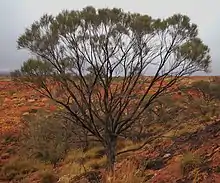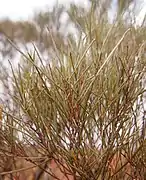Acacia macdonnelliensis
Acacia macdonnelliensis, commonly known as the MacDonnell mulga[3] or the Hill mulga,[4] is a species of Acacia native to central Australia.[5] The Indigenous Australians the Alyawarr peoples know the plant as irrar, the Kaytetye know it as arleth-arlethe or arwele arleth-arlethe and the Western Arrernte peoples know it as irrkwarteke.[6]
| Acacia macdonnelliensis | |
|---|---|
 | |
| Acacia macdonnellensis subsp. teretifolia | |
| Scientific classification | |
| Kingdom: | Plantae |
| Clade: | Tracheophytes |
| Clade: | Angiosperms |
| Clade: | Eudicots |
| Clade: | Rosids |
| Order: | Fabales |
| Family: | Fabaceae |
| Subfamily: | Caesalpinioideae |
| Clade: | Mimosoid clade |
| Genus: | Acacia |
| Species: | A. macdonnelliensis |
| Binomial name | |
| Acacia macdonnelliensis Maconochie | |
 | |
| Occurrence data from Australasian Virtual Herbarium | |
| Synonyms[1][2] | |
| |
Taxonomy
There are two subspecies:[1]
- Acacia macdonnelliensis subsp. macdonnelliensis Maconochie
- Acacia macdonnelliensis subsp. teretifolia Maslin
Description
This bushy shrub or tree typically grows 3 to 6 metres (10 to 20 ft) tall and has deeply fissured grey bark.[2] It has sparsely hoary to glabrous branchlets with obscure, resinous ridges. It has erect, glabrous to hoary, grey-green phyllodes with a narrow elliptic to linear shape that are 4 to 15 centimetres (2 to 6 in) in length and 0.8 to 5 millimetres (0.031 to 0.197 in) wide.[5] It produces yellow flowers in July.[2] The dense golden flower spikes are 0.6 to 3 cm (0.24 to 1.18 in) in length and have a width of 3 to 6 mm (0.118 to 0.236 in). After flowering linear pale brown seed pods form that are constricted between each seed. Each pod has a length of 3 to 9.5 cm (1.2 to 3.7 in) and is 2 to 4 mm (0.08 to 0.16 in) wide. The dark brown seeds within are arranged longitudinally and are 2.5 to 5 mm (0.1 to 0.2 in) long.[5]
 Bark (A. m. subsp. teretifolia)
Bark (A. m. subsp. teretifolia) Foliage (A. m. subsp. teretifolia)
Foliage (A. m. subsp. teretifolia)
Distribution and habitat
Acacia macdonelliensis is found in southern parts of the Northern Territory around Alice Springs and in far eastern Pilbara and north eastern Goldfields regions of Western Australia. It grows in areas of sandstone and quartzite along rocky ridges and creeklines.[2] A. macdonnelliensis is drought and frost tolerant.[4]
References
- "Acacia macdonnelliensis Maconochie". Plants of the World Online. Royal Botanic Gardens, Kew. Retrieved 29 November 2020.
- "Acacia macdonnelliensis". FloraBase. Western Australian Government Department of Biodiversity, Conservation and Attractions. Retrieved 28 November 2020.
- International Legume Database and Information Service (ILDIS) V10.39 Nov 2011
- "Acacia macdonnelliensis". Alice Springs Town Council. 2016. Retrieved 13 September 2016.
- "Acacia macdonnelliensis Maconochie, J. Adelaide Bot. Gard. 1: 183; 184, fig. 3 (1978)". World Wide Wattle. 12 July 2016. Retrieved 12 September 2016.
- "Acacia macdonnellensis Maconochie subsp. macdonnellensis". NT Flora. Northern Territory Government. Retrieved 24 September 2018.